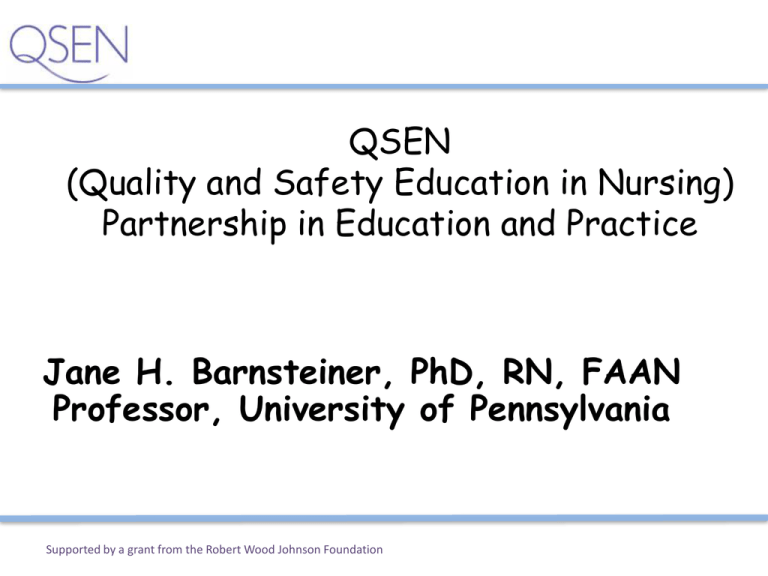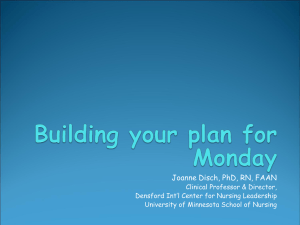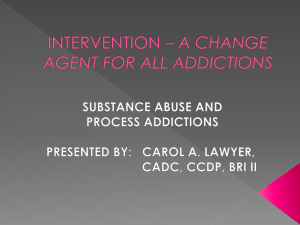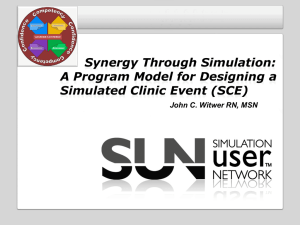
QSEN
(Quality and Safety Education in Nursing)
Partnership in Education and Practice
Jane H. Barnsteiner, PhD, RN, FAAN
Professor, University of Pennsylvania
Supported by a grant from the Robert Wood Johnson Foundation
Supported by a grant from the Robert Wood Johnson Foundation
In 2010…2011
• NYT – some hospital infection rates rise
• NYT – look- alike tubes kill patients
• USA Today - lax safety practices in
5000 ambulatory surgical centers
• USA Today – only 20% of USA hospitals
using WHO surgery checklist
• Wall Street Journal – Near misses
creeping up
Supported by a grant from the Robert Wood Johnson Foundation
Health Care Is Not As Safe
As It Could Be
• Deaths Per Year
– Medical Errors - 98,000
• Post-operative infections and other preventable
complications – 32,000/year
• 8% of hospitalized patients experience
preventable outcomes from adverse events.
– Motor Vehicle Accidents - 43,458
– Breast Cancer - 42,297
– AIDS – 16,000
Supported by a grant from the Robert Wood Johnson Foundation
Errors
• Medications – prescribing, dispensing,
administering
• Surgery – wrong site
• Diagnostic inaccuracy – wrong treatment
• Equipment failure – IV pump
• Transfusion error – blood type, wrong patient
• Laboratory – incorrect labeling
• System failure – no independent double check
• Environment – clean up spills
• Security – child abduction
Supported by a grant from the Robert Wood Johnson Foundation
Nurses at the “Sharp End”
Health Systems
Patients
Complex Needs
Nurses
Health Care Organizations
Working Conditions
Organizational Culture
Organizational Climate
Physicians
Human Factors
Teamwork
Perceptions
Communication
Critical
Thinking
Supported by a grant from the Robert Wood Johnson Foundation
Quality
Improvement
External Drivers
Cost Containment
Benchmarks
Institute Of Medicine’s (IOM) Quality Chasm
Series
Supported by a grant from the Robert Wood Johnson Foundation
External Drivers
IOM Chasm series
- Effective, Efficient, Safe, Timely,
Patient-Centered, Equitable
Public demand to know
- Reporting healthcare (e.g., hospital)
acquired infections to the state (i.e..,
DE, MN, NJ, NM, OR, TX, WA, etc.)
or CDC
Linking payment to quality of care
- Center for Medicare and Medicaid
Services (CMS) rule for healthcare
(e.g., hospital) acquired infections
began 10-1-07)
Patient Safety Act of 2005
by a grant from the Robert Wood Johnson Foundation
Supported
Priority:
Transparency
Judgments
Despite all of the quality improvement activities over the past few
years, the public’s perception of the health system is in decline
U.S. adults
who view
hospitals as
generally
trustworthy
and honest
35%
34%
29%
2004
Supported by a grant from the Robert Wood Johnson Foundation
SOURCE
: Harris Interactive Poll November 2010
2005
2010
What is quality care? (Institute of
Medicine, IOM)
•
•
•
•
•
•
S
T
E
E
E
P
a.k.a STEEEP
Supported by a grant from the Robert Wood Johnson Foundation
What is quality care?
•
•
•
•
•
•
S afe
T imely
E fficient
E quitable
E ffective
P atient-Centered
Supported by a grant from the Robert Wood Johnson Foundation
Do you know?
• What are the most frequently cited factors in
patient safety incidents (sentinel events )?
– Leadership
– Communication
– Orientation
– Staffing
• Do you know what a patient safety
incident/sentinel event is?
• Do you know what a serious reportable
event/‘never event’ is?
Supported by a grant from the Robert Wood Johnson Foundation
• A patient safety incident/sentinel event is
an unexpected occurrence involving death
or serious physical or psychological injury,
or the risk thereof.
• Serious injury specifically includes loss of limb
or function.
• Are called "sentinel" because they signal the
need for immediate investigation and response.
Supported by a grant from the Robert Wood Johnson Foundation
Sentinel Event Experience to Date
Of 5632 sentinel events reviewed by the Joint Commission,
January 1995 through December 2008:
741 wrong site surgery
698 inpatient suicides
631 operative/post op complications
492 medication errors
442 deaths related to delay in treatment
341 patient falls
218 assault/rape/homicide
212 foreign body left
189 deaths of patients in restraints
175 perinatal death/injury
132 transfusion-related events
113 infection-related events
105 medical equipment related
86 deaths following elopement
Supported by a grant from the Robert Wood Johnson Foundation
= 5632 Root
Cause Analyses
(RCA)
What’s a Serious Reportable Event
(SRE) ‘never event’?
• An error so serious it should never
happen: (n =29 6/13/11
www.qualityforum.org)
• Examples:
Surgery performed on the wrong body part
Surgery performed on the wrong patient
Infant discharged to the wrong person
Stage 3 or 4 pressure ulcers acquired after
admission to a healthcare facility
• Patient death associated with a fall while
being cared for in a healthcare facility
• Patient death or serious disability
associated with a medication error or blood
transfusion of wrong type
•
•
•
•
Supported by a grant from the Robert Wood Johnson Foundation
Supported by a grant from the Robert Wood Johnson Foundation
Supported by a grant from the Robert Wood Johnson Foundation
Supported by a grant from the Robert Wood Johnson Foundation
Return to
Normal
Technical
van der Schaaf- modified for
healthcare
Close Call
Organizational
Human
Factors
Patient
Factors
Dangerous
Situation
Adequate
defenses
ERROR
Developing
Errors
Supported by a grant from the Robert Wood Johnson Foundation
(Inadequate
Defenses)
Managing Healthcare Risk – The Three Behaviors
Normal Error
At-Risk
Behavior
Reckless
Behavior
Product of our
current
system design
Unintentional
Risk-Taking
Intentional
Risk-Taking
Manage through:
Manage through:
Manage through
changes in:
• Understanding our
at-risk behaviors
• Disciplinary action
• Processes
• Removing incentives
for at-risk behaviors
• Procedures
• Training
• Design
• Environment
• Creating incentives
for healthy behavior
• Increasing situational
awareness
Normal Error
*David Marx – Just Culture
Negligence?
Recklessness
Vigilance as a Safety Defense
Avoiding reliance on individual
vigilance
..because of the limits of human
ability to maintain a high level of
vigilance over prolonged periods
of time , it is important not to
rely upon a single individuals
vigilance ………
Keeping Patients Safe: Transforming the
Work Environment of Nurses, IOM, 2004
Supported by a grant from the Robert Wood Johnson Foundation
System Improvements
• System failure – decrease 75% of
adverse medication events:
– Standardize and simplify equipment and
supplies
– Use computer order entry
• Reduce prescribing errors by 50%
– Pharmacist on rounds
– Wireless computer and bar coding decrease
med errors 70% (VA)
Supported by a grant from the Robert Wood Johnson Foundation
What is RCA?
Root cause analysis/event analysis
• . . . a class of problem solving methods
aimed at identifying the root causes of
problems or events.
• Based on the belief that problems are
best solved by attempting to correct or
eliminate root causes, as opposed to
merely addressing the immediately
obvious symptoms.
Supported by a grant from the Robert Wood Johnson Foundation
What is FMEA?
• Failure Mode and Effects Analysis
• … a procedure for analysis of potential failure modes within a system
for classification by severity or determination of the effect of failures
on the system.
• Failure causes are any errors or defects in process, design,
or item, especially those that affect the customer, and can
be potential or actual.
• Effects analysis refers to studying the consequences of
those failures.
Supported by a grant from the Robert Wood Johnson Foundation
Most Frequently Identified Event Analysis/Roots Causes of Patient Safety
Incidents/Sentinel Events Reviewed by The Joint Commission by Year
The majority of events have multiple root causes
2008
(N=927)
2009
(N=936)
2010
(N=802)
Assessment
528
Assessment
580
Communication
1971
Care Planning
93
Care Planning
131
Leadership
1862
Communication
584
Communication
590
Assessment
1797
Continuum of Care
111
Continuum of Care
94
Human factors
1288
Human Factors
519
Human Factors
599
Physical Environment
824
Information Management
241
Information Management
243
Information Management
606
Leadership
584
Leadership
636
Operative Care
514
Medication Use
93
Medication Use
84
Care Planning
477
Operative Care
130
Operative care
131
Medication Use
268
Physical Environment
213
Physical Environment
234
Continuum of Care
226
Root Cause Information for Fall-related Events
Reviewed by The Joint Commission
(Resulting in death or permanent loss of function)
2004 through Fourth Quarter 2010 (N=366)
The majority of events have multiple root causes
Assessment
280
Communication
207
Leadership
201
Human Factors
189
Physical Environment
142
Care Planning
79
Information Management
57
Continuum of Care
32
Patient Education
27
Medication Use
20
Root Cause Information for Infection-related
Events Reviewed by The Joint Commission
2004 through Fourth Quarter 2010 (N=122)
The majority of events have multiple root causes
Leadership
61
Communication
60
Surveillance, Prevent. & Cotrl of Infect.
59
Human Factors
55
Assessment
44
Information Management
31
Care Planning
22
Physical Environment
20
Continuum of Care
14
Medication Use
10
Root Cause Information for Medical Equipmentrelated Events Reviewed by The Joint
Commission
(Resulting in death or permanent loss of function)
2004 through Fourth Quarter 2010 (N=137)
The majority of events have multiple root causes
Human Factors
98
Leadership
87
Physical Environment
85
Communication
84
Assessment
77
Information Management
20
Care Planning
18
Operative Care
6
Medication Use
5
Continuum of Care
4
Root Cause Information for Medication Error
Events Reviewed by The Joint Commission
(Resulting in death or permanent loss of function)
2004 through Fourth Quarter 2010 (N=291)
The majority of events have multiple root causes
Medication Use
251
Leadership
211
Communication
206
Human Factors
201
Assessment
116
Information Management
110
Physical Environment
51
Continuum of Care
32
Care Planning
29
Patient Education
7
Reporting Adverse Events and Near
Misses
• What happens after an adverse event or
near miss?
– Reporting systems in place, event analysis
processes?
• How are patients and families informed
of an unanticipated outcome?
• Who is accountable for patient safety?
• What is the process in your school of
nursing?
Supported by a grant from the Robert Wood Johnson Foundation
Making Care Safer
Supported by a grant from the Robert Wood Johnson Foundation
Improve Communication Skills
• Differences between therapeutic and professional
communication
• Skills to accurately describe situation, clearly
articulate positions and recommendations (SBAR =
Situation, Background, Assessment,
Recommendation)
• Skills in negotiation and conflict resolution
• Increased emphasis on ensuring that correct
message was heard
• Respect and valuing of each member of the team
drives communication
Supported by a grant from the Robert Wood Johnson Foundation
Benefits of Interprofessional
Collaboration
• Improved mortality outcomes after adjustment
for patient severity
• Increased patient and family satisfaction with
care
• Improved team perception of micro-system
conflict management, collaboration, job
satisfaction and quality of care
Supported by a grant from the Robert Wood Johnson Foundation
Raising the Bar
All health professionals should be
educated to deliver patient-centered
care as members of an interdisciplinary
team, emphasizing evidence-based
practice, quality improvement
approaches, and informatics.
Committee on Health Professions
Institute of Medicine (2003)
Supported by a grant from the Robert Wood Johnson Foundation
Education
“We can’t hope to make lasting changes
in the ability of health care systems to
improve without changes in the ways we
develop future health professionals.
Those changes require faculty and
schools to change.”
Paul Batalden
Dartmouth College
QSEN Advisory Board
Supported by a grant from the Robert Wood Johnson Foundation
Quality & Safety Education in Nursing
(QSEN)
• Purpose: to prepare nurses with the
competencies necessary to continuously
improve the quality and safety of the
health care systems in which they work
– Funded by RWJ Foundation
– PI: Linda Cronenwett, PhD, RN, FAAN
– Investigators for Phase 1: Jane
Barnsteiner, Joanne Disch, Jean Johnson,
Pam Mitchell, Dory Sullivan, Judith Warren
Supported by a grant from the Robert Wood Johnson Foundation
The Response from Medicine:
Accreditation Council for
Graduate Medical Education (ACGME)
ACGME identifies competencies all
residents must demonstrate
Residency program directors meet
annually prior to the Institute for
Healthcare Improvement (IHI)
National Forum to work on methods
of assessing competencies
Supported by a grant from the Robert Wood Johnson Foundation
Competencies
•
•
•
•
•
•
Patient/Family Centered Care
Teamwork and Collaboration
Safety
Evidence-based Practice
Quality Improvement
Informatics
Supported by a grant from the Robert Wood Johnson Foundation
Patient/Family Centered Care
• Old – Listen to patient and
demonstrate compassion and
respect.
• New - Recognize the patient or
designee as the source of control
and full partner in providing
compassionate and coordinated
care based on respect for
patient’s preferences, values and
needs
American Association of Colleges of Nursing. © 2010 - All Rights Reserved.
Collaboration and
Teamwork
• Old – Work side by side with
other HC professionals while
performing nursing skills.
• New - Function effectively
within nursing and interprofessional teams, fostering
open communication, mutual
respect, and shared decisionmaking to achieve quality
patient care
American Association of Colleges of Nursing. © 2010 - All Rights Reserved.
Evidence-Based Practice
• Old – Adhere to internal
policies and procedures.
• New - Integrate best
current evidence with
clinical expertise and
patient/family
preferences and values
for delivery of optimal
health care.
American Association of Colleges of Nursing. © 2010 - All Rights Reserved.
Quality Improvement
• Old – Update nursing policies
and procedures, chart audits
of documentation.
• New - Use data to monitor
outcomes of care processes
and improvement methods to
design and test changes to
continuously improve quality
and safety of health care
systems
American Association of Colleges of Nursing. © 2010 - All Rights Reserved.
Safety
• Old – focus on individual
performance, vigilance to
keep patients safe.
• New - Minimize risk of
harm to patients and
providers through both
system effectiveness and
individual performance
American Association of Colleges of Nursing. © 2010 - All Rights Reserved.
Informatics
• Old – timely and accurate
documentation
• New - Use information
and technology to
communicate, manage
knowledge, mitigate
error, and support
decision-making
American Association of Colleges of Nursing. © 2010 - All Rights Reserved.
QSEN Long-Range Goal
• Reshape professional identity formation
in nursing so that it includes
commitment to the implementation of
the IOM competencies
– Make it easy for faculty to envision roles in
supporting quality & safety education
– Transform education to transform practice
Supported by a grant from the Robert Wood Johnson Foundation
Any Improvement Requires…
• Will
• Ideas
• Execution
- Don Berwick
Supported by a grant from the Robert Wood Johnson Foundation
1. Build the will -
– Describe the gap between what is and
what could be
– Stimulate realization of why we need to
change
– Attract innovators
– Define the territory (desired
competencies)
Supported by a grant from the Robert Wood Johnson Foundation
10/05-3/07 Phase 1
• Proposed 6 competencies definitions and learning
objectives (KSAs) for pre-licensure education
– Faculty could identify gaps between current
curricular content and desired future
• Assessed state of q & s education in schools of
nursing nationwide
• Implemented website www.qsen.org to share teaching
strategies, annotated bibs & q & s research
• Presentations, publications, accrediting & licensing
Supported by a grant from the Robert Wood Johnson Foundation
4/07-10/08 Phase 2
• Developed graduate KSA competencies
– 11 specialty organizations
• Licensing and accrediting agencies for
pre-licensure and graduate programs
– AACN and NLN, NCSBN
• Pilot pre-licensure comps in 15 schools
Supported by a grant from the Robert Wood Johnson Foundation
Building Will - Graduate Education
• Graduate KSAs (Dec 2009, Nursing Outlook)
• NONPF Task Force led by Joanne Pohl crossmapped NONPF core NP competencies and
QSEN graduate KSAs
(Dec 2009, Nursing Outlook)
• AACN DNP Essentials mandated inclusion of
quality and safety competency development
• NONPF implemented special session on QSEN
competencies at annual meetings – May, 2010
Supported by a grant from the Robert Wood Johnson Foundation
4/07-10/08 Phase 2
• Delphi Study – placement of KSAs
– Beginning, intermediate, advanced content
• Published – Nursing Outlook 12/07,
5/09, J of Urologic Nursing, J of
Nursing Education
• Website – continued development
• Academic/Service Partnerships
Supported by a grant from the Robert Wood Johnson Foundation
Building Will - Publications
• Use of Collaborative model to build will and motivate
change (Dec 2009, Nursing Outlook)
• Report of survey of student perceptions of extent to
which they are learning the knowledge, skills &
attitudes related to QSEN competencies (Dec 2009,
Nursing Outlook)
• Kovner CT, Brewer CS, Yingrengreung S, Fairchild S.
New nurses' views of quality improvement education.
Joint Commission Journal on Quality and Patient
Safety, 2010: 36(1):29-5AP(-23)
• 39% of new nurses thought they were “poorly”
or “very poorly” prepared or “had never heard
of” QI
Supported by a grant from the Robert Wood Johnson Foundation
2. Generate and share ideas
– Outline the knowledge, skills, and
attitudes (KSAs) that would be logical
learning objectives for pre-licensure and
advanced practice curricula
– Stimulate and spread the ideas of early
adopters
– Share teaching strategies for classroom,
group work, simulation, clinical site
teaching, and inter-professional learning
Supported by a grant from the Robert Wood Johnson Foundation
Sharing Ideas– Special Issues
• 2007 May/June issue of Nursing
Outlook (Ed. Cronenwett)
• 2008 issue of Journal of Urologic
Nursing (Ed: Sherwood)
• 2009 Nov/Dec issue of Nursing
Outlook – (Ed:Cronenwett)
• 2009 Nov/Dec issue of Journal of
Nursing Education (Ed:Ironside)
Supported by a grant from the Robert Wood Johnson Foundation
11/08-2/12 Phase 3
• QSEN/AACN Faculty Institutes
– 9 2 ½ day train-the-trainer sessions
– 1200 faculty
•
•
•
•
National Forums
VA Quality Scholars
Consultation Service
Interprofessional Education - IPEC
Supported by a grant from the Robert Wood Johnson Foundation
Sharing Ideas
• QSEN National Forums – showcase innovation,
promote dissemination and dialogue
• QSEN Regional Institutes - ‘train the trainers’
• VA Quality Scholars – inter-professional learning
and development of future scholars
• QSEN Consultants
• QSEN website
www.qsen.org
Supported by a grant from the Robert Wood Johnson Foundation
Video-based Learning Modules
Supported by a grant from the Robert Wood Johnson Foundation
Faculty Self-Development
Modules
Editor: Pam Ironside, IUPUI
• Getting Started with QSEN: Why is QSEN
Important to Nursing Clinical Education?
• Managing the Complexity of Nursing Work:
Cognitive Stacking
• Introduction to Teaching Informatics in Clinical
Courses
• Inter-professional education
• Evaluation of QSEN competencies
• Changing a curriculum
• Integrating QSEN in intermediate level courses
• Integrating QSEN in advanced courses
Supported by a grant from the Robert Wood Johnson Foundation
Sharing Ideas –
QSEN Regional Institutes
•
•
•
•
•
•
•
•
•
San Antonio, TX January 13-15, 2010
Washington, DC April 14-16, 2010
Palo Alto, CA June 9-11, 2010
Minneapolis, MN September 22-24, 2010
Phoenix, AZ January 12-14, 2011
Chicago, IL March 16-19, 2011
Boston, MA June 8-10, 2011
Seattle, WA September 14-16, 2011
Charleston, SC November 2-4, 2011
Supported by a grant from the Robert Wood Johnson Foundation
QSEN Forum – Tucson, AZ
May 30-31, June 1, 2012
Supported by a grant from the Robert Wood Johnson Foundation
Support Execution 11/08-2/12
Phase 3
• Text – Quality & Safety in Nursing: A
Competency Approach to Improving
Outcomes.
• Content in NCLEX and certification
exams
• Days of Dialogue – Academic/Service
Partners
Supported by a grant from the Robert Wood Johnson Foundation
Support execution Phase 4
2012-2013
– Create website resources for faculty and
students
– Train early adopters to train others
– Share products with professional
organizations involved in licensure,
certification and accreditation of education
and transition to practice residency
programs
– Seek support from publishers and authors
to integrate quality and safety concepts in
textbooks
Supported by a grant from the Robert Wood Johnson Foundation
Supporting Execution
• Accreditation standards
– AACN – BSN and DNP Essentials
– NLN – Competency Development Task Force
– NONPF – Core Competency work
• Licensure
– NCSBN Transition to Practice Residency
Program Proposal
– State level QI requirements for relicensure
• Certification - the next frontier
Supported by a grant from the Robert Wood Johnson Foundation
Michigan Task Force on Nursing Education
(April, 2010)
Nursing Education Position Papers (NEPPs):
• National accreditation for all nursing programs in
Michigan
• All nursing education programs in
Michigan must make quality and
safety a priority
• Nurse residency programs required in Michigan for newly
licensed graduates of all nursing education programs
• Increase the capacity of nursing education to graduate
more advanced practice registered nurses
• Financing of nursing education in Michigan
• Improve nursing education through the Michigan Nursing
Education Council
Supported by a grant from the Robert Wood Johnson Foundation
West Virginia Center for Nursing
Duane Napier, Executive Director
Statewide Implementation of Quality and
Safety Education for Pre-licensure Nursing
Programs in West Virginia Schools of
Nursing
Approved by the WV Association of Deans and
Directors of Nursing Education
• Phase 1 – 3 pre-licensure programs
• Phase 2 – 4 additional RN and 1 LPN program to
join
Supported by a grant from the Robert Wood Johnson Foundation
Support Execution 2012 – 2013
Phase 4
• Annual National Forum
• Graduate Education Institutes
• NCSBN funded study on Just Culture
– Data repository of nursing student errors
and near misses
Supported by a grant from the Robert Wood Johnson Foundation
Supported by a grant from the Robert Wood Johnson Foundation
Closing the Gaps – What Can You Do?
• What do you need to learn?
• How can you add content (KSAs) across
your curricula and in your courses?
• How can you role model curiosity about the
QSEN work and its potential?
• What can you do in the next week/month/
semester to advance this effort?
• How can you foster Academic Service
Partnerships?
• Who can you work with?
Supported by a grant from the Robert Wood Johnson Foundation
Attendees
• Why are you here?
• To create a sea change
• Why is it important?
• We need to prepare our graduates for
today’s health care arena
• Why does it matter?
• Patients lives are at stake
Supported by a grant from the Robert Wood Johnson Foundation
CHANGE THE WORLD
OF HEALTH CARE
– Start where you are
– Use what you have
– Do what you can
• A. Ashe
Supported by a grant from the Robert Wood Johnson Foundation








